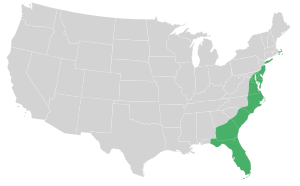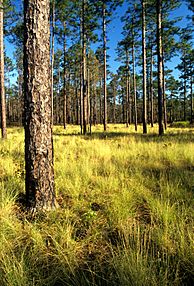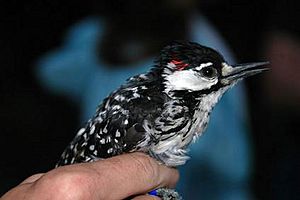Atlantic Plain facts for kids
The Atlantic Plain is one of the eight main natural areas, called physiographic regions, in the United States. It includes parts of many coastal states. These states are Delaware, Florida, Georgia, Maryland, Massachusetts, New Jersey, New York, North Carolina, South Carolina, and Virginia.
The land along the Atlantic coast has sandy beaches, marshlands, bays, and barrier islands. This huge area includes the continental shelf and the coastal plain. It is the flattest of all the U.S. natural regions. It stretches over 2,200 miles (3,500 km) from Cape Cod all the way to the Mexican border. It then goes another 1,000 miles (1,600 km) south to the Yucatán Peninsula. The central and southern Atlantic Coast has many barrier islands and river valleys that are now underwater. The Atlantic Plain gently slopes towards the ocean from the higher lands inland. This gentle slope continues far into the Atlantic Ocean and the Gulf of Mexico, forming the continental shelf. The land and sea often blend together, especially in places like the Louisiana bayous and the Florida Everglades.
Coastal Plains
The Atlantic Coastal Plain is mostly made of layers of sand and clay. These layers have not yet turned into hard rock. This area has many barrier islands that are broken up by inlets. It also has large bays with river valleys that are now flooded. You can find many wetlands and marshes here too.
This plain stretches about 2,200 miles (3,500 km) from the New York Bight south to a part of Georgia and Florida. This area is bordered by the Atlantic Seaboard Fall Line and the Piedmont plateau to the west. The Atlantic Ocean is to the east. The average height of this area is less than 900 meters (3,000 ft) above sea level. It reaches about 50 to 100 kilometers (30 to 60 miles) inland from the ocean.
The coastal plain is usually wet. It has many rivers, marshes, and swamplands. It is mostly made of sedimentary rock and loose sediments. People mainly use this land for farming. The Atlantic Coastal Plain is sometimes divided into northern and southern parts. These are the Mid-Atlantic and South Atlantic coastal plains. The surface is mostly flat, and many people live here. The large number of people living here greatly affects the local wildlife.
Geology
The Atlantic Plain is generally made of gently sloping layers of Mesozoic and Cenozoic sediments. These layers are not folded or broken. The layers of sediment get thicker towards the sea. They reach a maximum thickness of about 3 kilometers (10,000 ft) near Cape Hatteras, North Carolina.
Ecology
Flora (Plants)
The Atlantic Coastal Plain is now known as a global hotspot for different kinds of plants and animals. It has over 1,500 types of plants that are found nowhere else in the world. About 70% of their natural homes have been lost. Many of these unique plants live in the longleaf pine savannas and woodlands. These areas, and other grassy, fire-dependent ecosystems, have many special plants. Even with some flooding, certain areas have stayed dry land since at least the late Cretaceous period (85-80 million years ago). This has helped many unique species to develop here.
Generally, the soil in this region does not have many nutrients. This is because much of the soil drains water well, making it dry. This leads to many xeric plants that can live in dry conditions. However, there are also many wet areas with wetlands and hammocks, which are important natural features.
The Eastern woodlands were the main natural environment of the Atlantic Coastal Plain. The Atlantic coastal plain upland longleaf pine woodland is a special plant community found in most of the Atlantic Coastal Plain. It stretches from Virginia to northern Florida. These woodland savannas need sandy soils and depend on fires to stay healthy. Without fires, other trees would take over. Along with longleaf pine, you often find turkey oak and wiregrass.
Fauna (Animals)
The Atlantic Plain is home to many animals that are mostly found only in this region. There are many different kinds of amphibians here.
North
- Pine Barrens tree frog (Dryophytes andersonii)
- Northern red-bellied cooter (Pseudemys rubriventris)
- Heath hen (Tympanuchus cupido cupido) EX (This animal is now extinct)
- Beach vole (Microtus breweri)
- Red wolf (Canis rufus)
South
Some of these animals can also be found in the longleaf pine woodlands and savannas of the Gulf Plain.
- Red-cockaded woodpecker (Picoides borealis)
- Brown-headed nuthatch (Sitta pusilla)
- Bachman's sparrow (Peucaea aestivalis)
- Florida scrub jay (Aphelocoma coerulescens)
- Ivory-billed woodpecker (Campephilus principalis) EX (This animal is now extinct)
- American alligator (Alligator mississippiensis)
- Gopher tortoise (Gopherus polyphemus)
- Chicken turtle (Deirochelys reticularia)
- Florida worm lizard (Rhineura floridana)
- Eastern indigo snake (Drymarchon couperi)
- Eastern diamondback rattlesnake (Crotalus adamanteus)
- Southeastern pocket gopher (Geomys pinetis)
- Round-tailed muskrat (Neofiber alleni)
- Two-toed amphiuma (Amphiuma means)
- Oak toad (Anaxyrus quercicus)
- Frosted flatwoods salamander (Ambystoma cingulatum)
- Striped newt (Notophthalmus perstriata)
See also
 In Spanish: Llanura atlántica para niños
In Spanish: Llanura atlántica para niños





